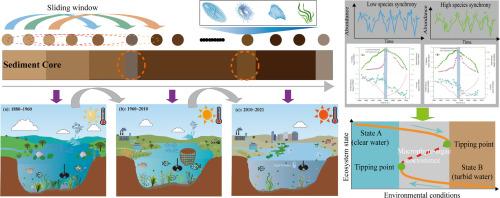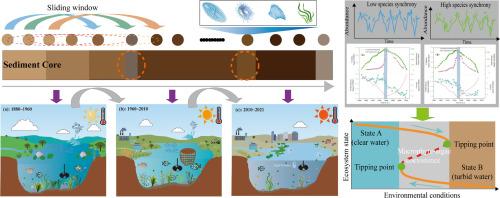Aquatic community synchrony dynamics in response to multitrophic regime shifts: Paleoecological insights from a shallow lake
IF 12.4
1区 环境科学与生态学
Q1 ENGINEERING, ENVIRONMENTAL
引用次数: 0
Abstract
Ecological synchrony, the coordinated fluctuation of species or communities, is central to ecosystem stability. Yet how synchrony changes during ecological shifts remains poorly understood. This gap is particularly evident in shallow lakes, where transitions from clear, macrophyte-dominated to turbid, algae-dominated state can dramatically alter synchrony patterns, challenging ecosystem resilience. Here, we integrate century-scale multi-proxy sedimentary records (algal pigments, macrophyte macrofossils, diatom and cladoceran remains) with remote sensing data, to investigate both intra- and inter-community synchrony dynamics throughout multitrophic regime shifts in Lake Liangzi, an iconic shallow lake in eastern China floodplain. Our results reveal that the lake ecosystem experienced two distinct ecological shifts, occurring around the 1960s and 2010s. The lake was initially submerged macrophyte-dominated with low macrophyte community synchrony and limited phytoplankton abundance. Since 1960, the lake entered a gradually transitional phase due to damming and agricultural impacts, with nutrient enrichment, increased algal production, and macrophyte shifts to emergent floating groups. Correspondingly, the synchrony of algal community decreased, but macrophyte synchrony increased towards decline in community stability. Around the mid-2010s, the lake shifted to an algae-dominated regime, characterized by algal proliferation at low synchrony and sustained high synchrony within the degraded macrophyte community. Our ordination analysis identified hydrological regulation, intensified nutrient loading and rising temperatures as main drivers underlying the regime shift. The findings highlight how ecological synchrony modulates ecosystem resilience to environmental disturbances. This study underscores the importance of asynchronous responses in bolstering ecological stability and that synchrony should be recognized as a key indicator of ecological state transitions in shallow lakes.


水生群落同步动力学对多营养状态变化的响应:来自浅湖的古生态学见解
生态同步性,即物种或群落的协调波动,对生态系统的稳定至关重要。然而,人们对生态变化过程中的同步性变化知之甚少。这种差距在浅湖中尤为明显,在浅湖中,从清澈的、以大型植物为主的状态过渡到浑浊的、以藻类为主的状态,可以极大地改变同步模式,挑战生态系统的恢复能力。本研究将世纪尺度的多代沉积记录(藻类色素、大型植物化石、硅藻和枝海化石)与遥感数据相结合,研究了中国东部漫滩标志性浅湖梁子湖在多营养状态变化过程中的群落内和群落间同步动力学。研究结果表明,湖泊生态系统经历了两次明显的生态转变,分别发生在20世纪60年代和2010年代左右。湖泊初期以淹没植物为主,群落同步性低,浮游植物丰度有限。自1960年以来,由于筑坝和农业影响,湖泊进入逐渐过渡阶段,营养物富集,藻类产量增加,大型植物转向新兴的漂浮群。相应的,藻类群落的同步性降低,而大型植物群落的同步性增加,群落稳定性下降。在2010年代中期前后,湖泊转向以藻类为主的状态,在退化的大型植物群落中,藻类增殖处于低同步状态,持续高同步状态。我们的协调分析发现,水文调节、营养负荷加剧和气温上升是气候变化的主要驱动因素。这些发现强调了生态同步性如何调节生态系统对环境干扰的恢复能力。我们的研究强调了非同步响应在增强生态稳定性中的重要性,并且应将同步性视为浅湖生态状态转变的关键指标。
本文章由计算机程序翻译,如有差异,请以英文原文为准。
求助全文
约1分钟内获得全文
求助全文
来源期刊

Water Research
环境科学-工程:环境
CiteScore
20.80
自引率
9.40%
发文量
1307
审稿时长
38 days
期刊介绍:
Water Research, along with its open access companion journal Water Research X, serves as a platform for publishing original research papers covering various aspects of the science and technology related to the anthropogenic water cycle, water quality, and its management worldwide. The audience targeted by the journal comprises biologists, chemical engineers, chemists, civil engineers, environmental engineers, limnologists, and microbiologists. The scope of the journal include:
•Treatment processes for water and wastewaters (municipal, agricultural, industrial, and on-site treatment), including resource recovery and residuals management;
•Urban hydrology including sewer systems, stormwater management, and green infrastructure;
•Drinking water treatment and distribution;
•Potable and non-potable water reuse;
•Sanitation, public health, and risk assessment;
•Anaerobic digestion, solid and hazardous waste management, including source characterization and the effects and control of leachates and gaseous emissions;
•Contaminants (chemical, microbial, anthropogenic particles such as nanoparticles or microplastics) and related water quality sensing, monitoring, fate, and assessment;
•Anthropogenic impacts on inland, tidal, coastal and urban waters, focusing on surface and ground waters, and point and non-point sources of pollution;
•Environmental restoration, linked to surface water, groundwater and groundwater remediation;
•Analysis of the interfaces between sediments and water, and between water and atmosphere, focusing specifically on anthropogenic impacts;
•Mathematical modelling, systems analysis, machine learning, and beneficial use of big data related to the anthropogenic water cycle;
•Socio-economic, policy, and regulations studies.
 求助内容:
求助内容: 应助结果提醒方式:
应助结果提醒方式:


